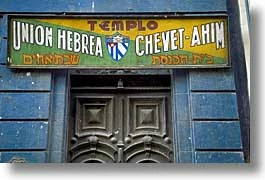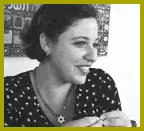

photos by Dan Heller
Adio Kerida/Goodbye Dear Love: A Cuban Sephardic Journey
with Award-Winning Anthropologist, Writer and Documentarian
Ruth Behar


photos by Dan Heller
Adio Kerida/Goodbye Dear Love: A Cuban Sephardic Journey
with Award-Winning Anthropologist, Writer and Documentarian
Ruth Behar
Based on interviews and frequent trips to the island, Behar offers a provocatively compelling portrait of the Sephardic Jews remaining in Cuba and the Cuban diaspora in the U.S. In an attempt to debunk current myths and illuminate an under-represented cultural group, she will explore diverse issues, including intermarriage, discrimination from the Ashkenazi Jewish community, Afro-Cuban santería, renewal of Jewish faith, and how the new Cuban identity interplays with being Sephardic. Behar weaves a fascinating presentation in English and Spanish.

Miguelito |

Elisa |

Roberto |
video excerpts by Ruth Behar
Ruth Behar is the author most recently of The Vulnerable Observer: Anthropology That Breaks Your Heart (Beacon). Other works include The Translated Woman,and (as editor) Bridges to Cuba/Puentes a Cuba. A respected poet as well as a non-fiction writer, Behar helped to cofound Ivri-NASAWI.
Adio Kerida will be submitted to film festivals for jury consideration. Additional funds are urgently needed to complete editing and post-production, create marketing materials, and to promote the film for educational purposes.If you would like to become a supporter of this effort, please choose one of the following categories:
Friends ($100-400) receive a complementary copy of the film plus two tickets to a private gala.
Sponsors ($500-$900) receive a complementary copy of the film plus four tickets to a private gala.
Benefactor ($1000 and above) receive the benefits of sponsors plus special listing in the film.
Tax-deductible contributions towards the completion costs of Adio Kerida/Goodbye Dear Love: A Cuban Sephardic Journey should be made payable to the "University of Michigan," with "Ruth Behar/Adio Kerida" in the memo line. For your records, the tax i.d. # is 38-6006309. Checks may be sent to "Adio Kerida," Ivri-NASAWI, 1033 N. Orlando Ave., Los Angeles CA 90069 for registration purposes.
More about the film and the filmmaker:Adio Kerida is a personal documentary about the search for identity and history among Sephardic Jews with roots in Cuba. The title of the documentary, "Adio Kerida," is borrowed from a Sephardic love song in order to highlight the themes of expulsion, departure, and exile that are at the crux of the Sephardic legacy.
At the same time, the title invokes the creative energy that is injected into a culture when it crosses racial, ethnic, and national lines. It also has a personal dimension and references the desire for reconciliation between the filmmaker and her Sephardic father.
Personal narration, intimate interviews with Sephardic Jews in Cuba and Cuban Miami, as well as family stories, are meshed with probing footage of dilapidated Jewish cemeteries and new Judaic rituals in Cuba to create a filmic memoir that offers a uniquely poetic and humanistic anthropological vision. The result is a documentary that makes its diverse protagonists come alive and shows how the filmmaker is transformed by her journey.
The film begins with the Cuban-born filmmaker's own search for memory in Cuba. Having left as a child, she cannot remember Cuba. So she returns over and over to the island to see what she can learn about herself and "her people" in the Cuba of today. She discovers that the one thousand Jews remaining on the island, almost all of them Sephardic, are constantly being observed, photographed, filmed, and given charity by Jewish tourists from the United States who have recently discovered the exotic tribe of "Castro's Jews" and want to see them in action before they disappear. As a Cuban Sephardic Jew herself, the filmmaker refrains from treating the Jews on the island as a sad group of castaways and delves deeply into the way the members of the Sephardic Jewish community in Cuba bring meaning, joy, song, and laughter to their everyday lives.
While the filmmaker's story informs her journey, it never overpowers the stories of her protagonists, each of whom is seen as an individual with his or her compelling quest to create an identity out of the mixture of Cuban and Sephardic cultural elements. Conversion, intermarriage, and cultural mixing, or mestizaje,are recurrent themes in the stories. The cinematography and the narrative are juxtaposed with music that transcends the history being told with Afro-Cuban drumming, Jewish liturgical music, Sephardic love songs, tangos, boleros, oud solos, flamenco, Cuban salsa, and American jazz. The diverse range of forms embraced by Cuban Sephardim becomes a vivid presence in the documentary. Song, music, and dance emerge as a vital necessity in the lives of the Sephardic Jews of Cuba.
In Cuba, we hear the voices of Afro-Cuban children who affirm their Sephardic heritage, adult men and women who were hidden Jews and have returned to their faith through conversion, and elderly Jews who celebrate Che Guevara's legacy, sing tango songs and love songs, and explore the fine line between forgetting and remembering.
In Miami, we hear from sellers of good luck charms, a gay hairdresser who celebrates the marriage of his Cuban Sephardic mother and Cuban Catholic father, a belly-dancer who merges flamenco, Afro-Cuban, and Turkish traditions, and the aging former rabbi of the Sephardic community of Havana. And at the end of the journey, the video daringly explores the life of the filmmaker herself as she returns home. We follow her as she learns family secrets from her Sephardic relatives in Miami, then moves on to an encounter with her Sephardic father, who distrusts her motives in making the film, and finally see her interacting with her brother, a jazz musician who questions the purpose of anthropology and her hunger to travel to other places.
Issues of diversity and multiculturalism are presented through an examination of Jewish identity as it merges with Cuban and Latino identity. Stereotypes and mainstream images of both Jews and Latinos are challenged by showing that Jews can be Latinos and Latinos can be Jews.Sephardic Jews view themselves as Hispanic people who are connected to both the Arab and African worlds because of their history of cultural and emotional interpenetration with those worlds. They descend from the Jewish populations expelled by the Spanish Inquisition in the fifteenth century. "Sepharad" means Spain in Hebrew. Sephardic Jews are notable for having clung with a passion to their nostalgia for Spain and their love for the Spanish language, despite having been forced to leave Spain because of their ethnic and religious identity. They are misunderstood and often discriminated against by the mainstream Eastern European Jewish world, which can only imagine Jewish identity in terms of the novels of Philip Roth and the movies of Woody Allen. Beyond the Jewish world, Sephardic Jews are virtually unknown as a community and they are almost invisible in the contemporary world of literature and the arts. The Cuban Sephardic community, both on and off the island, offers so rare a mix of cultural traditions--Spanish, Turkish, African, Jewish, Cuban, and American--that it remains a mystery and has not yet been portrayed in any depth in literature, art, or film.
Adio Kerida is a story of continuing diasporas and intercultural adaptations. Thus, when the filmmaker's mother blissfully digs her teeth into a mango synonymous with the flavor and the scent of a Cuba she left behind, we are reminded of Proust's madeleine, and led to reflect on the search for a lost time that continues to leave its mark on the fleeting moments of the present.
RUTH BEHAR was born in Havana, Cuba and came to live in New York with her family in 1962. Behar has traveled to Spain, Mexico, and Cuba and written on a range of cultural issues as a poet, essayist, editor, and ethnographer. She was awarded the MacArthur "genius" award in 1988 at the start of her career as an anthropologist, and has been the recipient of many prestigious fellowships for her work, including a John Simon Guggenheim award in 1995. She received the Distinguished Alumna Award in Recognition of Outstanding Achievement and Service from Wesleyan University in 1997. Latina Magazinenamed her, in 1999, one of the 50 Latinas who made history in the twentieth century.
Her books include The Presence of the Past in a Spanish Village: Santa Mar°a del Monte (Princeton, 1986; expanded paperback edition, 1991), Translated Woman: Crossing the Border with Esperanza's Story (Beacon Press, 1993), and The Vulnerable Observer: Anthropology That Breaks Your Heart (Beacon Press, 1996). Behar is the co-editor of Women Writing Culture (University of California Press, 1995). As the editor of Bridges to Cuba/Puentes a Cuba (University of Michigan Press, 1995), she sought to create a forum for the voices of Cubans on the island and in the diaspora seeking reconciliation and a common culture and memory. She has traveled to Cuba more than thirty times in the last nine years, seeking personal, spiritual, and intellectual connections with the country of her birth.
A respected, visible, and provocative scholar, Behar is also known for her literary essays, poetry, fiction, and new work as an emerging filmmaker. Her personal essays have appeared in the anthologies, The Female Body: Figures, Styles, Speculations (University of Michigan Press, 1991), Her Face in the Mirror: Jewish Women on Mothers and Daughters (Beacon Press, 1994), and King David's Harp: Autobiographical Essays by Jewish Latin American Writers (University of New Mexico Press, 1999). Her fictional story "La Cortada" was selected by Joyce Carol Oates for inclusion in the anthology Telling Stories: An Anthology for Writers(Norton, 1997), a text used widely in creative writing courses. Another of her short stories recently appeared in Marjorie Agosín's The House of Memory: Stories by Jewish Women Writers of Latin America (The Feminist Press, 1999).
Behar's poems have been published in Witness, Michigan Quarterly Review, Tikkun, Latino Stuff Review, Brújula, Prairie Schooner, The American Voice, and Bridges, as well as in the anthologies Sephardic American Voices: Two Hundred Years of a Literary Legacy (Brandeis University Press, 1996), Little Havana Blues: A Cuban-American Literature Anthology (Arte Público Press, 1996), and The Prairie Schooner Anthology of Jewish-American Writers, edited by Hilda Raz (Lincoln: University of Nebraska Press, 1998). A chapbook of her poems, Poemas que vuelven a Cuba/Poems Returned to Cuba was published in Matanzas, Cuba by Vigía, an editorial collective that produces handmade artisanal books in small editions. She has completed a collection of prose poems, Everything I Kept/Todo lo que guardó,that explores the theme of loss and will be published in Cuba.
Behar is currently writing a novel, Nightgowns from Cuba,that mixes fiction and nonfiction to tell the story of her Jewish-Cuban family's journey from Europe to Cuba to the United States as seen through the eyes of the Afro-Cuban woman, still living on the island, who was her caretaker as a child. She is also currently directing and producing Adio Kerida/Goodbye Dear Love: A Cuban Sephardic Journey, a video documentary about searching for memory based on the life stories of Sephardic Cuban Jews living in Cuba, Miami, and New York. As an emerging filmmaker, she seeks to bring her humanistic, poetic, and strongly personal vision of cultural anthropology to the art of the documentary film.
Behar received her B.A. in Letters (1977) from Wesleyan University, and her M.A. (1980) and Ph.D. in Cultural Anthropology (1983) from Princeton University. She is Professor of Anthropology at the University of Michigan.
A respected public speaker who has appeared at such institutions as the Getty Center and the Skirball Cultural Center, Ruth Behar is a co-founder of Ivri-NASAWI, the New Association of Sephardi/Mizrahi Artists and Writers International, which promotes the history, culture and creative achievements of its members and others in Los Angeles, New York, the San Francisco Bay Area and Washington, D.C.
Visit Ruth Behar's new website.
[home] [org] [news] [calendar] [membership] [links] [open tent] [past]